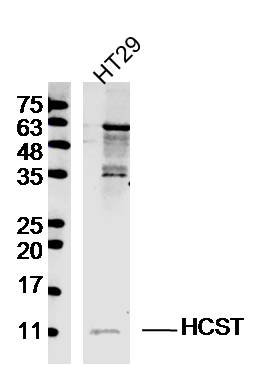
Rabbit Anti-HCST antibody
DAP10; DNAX activation protein 10; Hematopoietic cell signal transducer; KAP10; Membrane protein DAP10; phosphoinositide 3 kinase adaptor protein; PIK3AP; Transmembrane adapter protein KAP10; HCST_HUMAN.
View History [Clear]
Details
Product Name HCST Chinese Name 造血细胞Signal transduction蛋白抗体 Alias DAP10; DNAX activation protein 10; Hematopoietic cell signal transducer; KAP10; Membrane protein DAP10; phosphoinositide 3 kinase adaptor protein; PIK3AP; Transmembrane adapter protein KAP10; HCST_HUMAN. Research Area immunology Signal transduction Immunogen Species Rabbit Clonality Polyclonal React Species Human, Applications WB=1:500-2000 ELISA=1:5000-10000
not yet tested in other applications.
optimal dilutions/concentrations should be determined by the end user.Theoretical molecular weight 8kDa Cellular localization The cell membrane Form Liquid Concentration 1mg/ml immunogen KLH conjugated synthetic peptide derived from human HCST: 11-50/93 <Extracellular> Lsotype IgG Purification affinity purified by Protein A Buffer Solution 0.01M TBS(pH7.4) with 1% BSA, 0.03% Proclin300 and 50% Glycerol. Storage Shipped at 4℃. Store at -20 °C for one year. Avoid repeated freeze/thaw cycles. Attention This product as supplied is intended for research use only, not for use in human, therapeutic or diagnostic applications. PubMed PubMed Product Detail This gene encodes a transmembrane signaling adaptor that contains a YxxM motif in its cytoplasmic domain. The encoded protein may form part of the immune recognition receptor complex with the C-type lectin-like receptor NKG2D. As part of this receptor complex, this protein may activate phosphatidylinositol 3-kinase dependent signaling pathways through its intracytoplasmic YxxM motif. This receptor complex may have a role in cell survival and proliferation by activation of NK and T cell responses. Alternative splicing results in two transcript variants encoding different isoforms. [provided by RefSeq, Jul 2008]
Function:
Transmembrane adapter protein which associates with NKG2D to form an activation receptor NKG2D-HCST in lymphoid and myeloid cells; this receptor plays a major role in triggering cytotoxicity against target cells expressing cell surface ligands such as MHC class I chain-related MICA and MICB, and UL16-binding proteins (ULBPs); these ligands are up-regulated by stress conditions and pathological state such as viral infection and tumor transformation. Functions as docking site for PI3-kinase PIK3R1 and GRB2. Interaction of ULBPs with NKG2D-DAP10 triggers calcium mobilization and activation of the PIK3R1, MAP2K/ERK, and JAK2/STAT5 signaling pathways. Both PIK3R1 and GRB2 are required for full NKG2D-HCST-mediated activation and ultimate killing of target cells. In NK cells, NKG2D-HCST signaling directly induces cytotoxicity and enhances cytokine production initiated via DAP12/TYROBP-associated receptors. In T-cells, it provides primarily costimulation for TCR-induced signals. NKG2D-HCST receptor plays a role in immune surveillance against tumors and is required for cytolysis of tumors cells; indeed, melanoma cells that do not express NKG2D ligands escape from immune surveillance mediated by NK cells.
Subunit:
Interacts with CLEC5A. Forms an CLEC5A/TYROBP/HCST trimolecular complex depending almost solely on TYROBP. Homodimer; Disulfide-linked. Interacts with NKG2D to form a stable complex, which results in surface expression of both proteins, whereas alone, it is minimally expressed. Interacts with PIK3R1 and GRB2.
Subcellular Location:
Membrane; Single-pass type I membrane protein.
Tissue Specificity:
Predominantly expressed in hemopoietic cells such as NK cells, subset of T-cells and monocytes. Detected in leukocytes, spleen, and thymus.
Post-translational modifications:
Phosphorylated; PIK3R1 and GRB2 associate specifically with tyrosine-phosphorylated HCST.
O-glycosylated.
Similarity:
Belongs to the DAP10 family.
SWISS:
Q9Y3Y0
Gene ID:
10870
Database links:Entrez Gene: 10870 Human
SwissProt: Q9Y3Y0 Human
Product Picture
References (0)
No References
Bought notes(bought amounts latest0)
No one bought this product
User Comment(Total0User Comment Num)
- No comment



 +86 571 56623320
+86 571 56623320
 +86 18668110335
+86 18668110335

